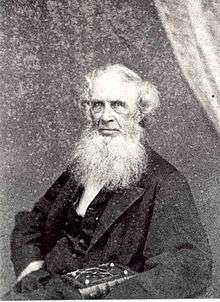Cyrus Pitt Grosvenor
| Cyrus Pitt Grosvenor | |
|---|---|
 | |
| Born |
October 18, 1792 Grafton, Massachusetts |
| Died |
February 11, 1879 Albion, Michigan |
| Nationality | American |
| Education | Dartmouth College |
| Occupation | Baptist minister |
| Known for | Anti-slavery, education |
| Spouse(s) | Sarah Warner |
| Parent(s) | Rev. Daniel and Deborah Grosvenor |
Cyrus Pitt Grosvenor (October 18, 1792 – February 11, 1879) was an American Baptist minister known for his anti-slavery views. In his retirement he worked on a famous mathematics problem and took out a patent to prevent lamp explosions.
Biography
Cyrus Pitt Grosvenor was born in Grafton, Massachusetts. He graduated from Dartmouth College in 1815.[1] He was a minister for congregations in New Haven, Salem and Boston (1827–40) from 1825 to 1834. Grosvenor was a leader of the anti-slavery movement in Massachusetts and Connecticut, and an agent of the American Anti-Slavery Society. The first meeting of the Essex County Anti-Slavery Society was held at his house.[2]

- ^ The Anti-Slavery Society Convention, 1840, Benjamin Robert Haydon, 1841, National Portrait Gallery, London, NPG599, Given by British and Foreign Anti-Slavery Society in 1880
Grosvenor and Elon Galusha were the two leading Baptist ministers opposing slavery at the time. Grosvenor was a proponent of the anti-slavery Liberty Party.[3] In 1840 he attended the Anti-Slavery Convention in London where he was included in the commemorative painting by Benjamin Haydon, although Grosvenor's face is obscured by Galusha and Henry Sterry. There was a delegation from Massachusetts that included Galusha, George Bradburn, Lydia Maria Child, Harriet Martineau, William Lloyd Garrison, Wendell Phillips and Maria Weston Chapman. In the same year, Grosvenor published a book which investigated the case for whether slavery was scripturally justified by the bible.[4]
Grosvenor was the founding editor of the Baptist Anti-Slavery Correspondent which was first published in February 1841 in Worcester, Massachusetts.[5]
In 1844, Grosvenor led the formation of an American Missionary Society. He was disappointed that Baptist church leaders were unwilling to eject people involved with slavery from the church. He decided that a new organization was required to take a stronger moral position.[3]
Grosvenor married Mrs. Sarah Warner and they had three children, but only Sarah Caroline Grosvenor did not die young. Sarah married Baptist Rev. Austin Harman in 1852. When the Harmans moved to Allegan County in Michigan, the Grosvenors followed them. Grosvenor had retired from the college the year after his daughter married. In 1856, Grosvenor’s wife died.[6]
Science
In 1867, Grosvenor applied for a patent for an idea he had to prevent lamps from exploding by using a reservoir of nitrogen.[7] The following year Grosvenor published a study in mathematics relating to the problem of squaring the circle. The problem is an old one and can be stated simply as "Is it possible to construct a square with the same area as a given circle using only a compass and ruler". Grosvenor described a method in a pamphlet titled The circle squared a method for determining the area of a circle squared that as a result gave a value for π (Pi) that was 3.142135… (Pi is 3.14159…).
Square the diameter of the circle; multiply the square by 2; extract the square root of the product; from the root subtract the diameter of the circle; square the remainder; multiply this square by four fifths; subtract the square from the diameter of the circle.[8]
This gave a small but real error. The success of the method was measured by the error only being 0.000543[8] It was later proved (in 1882) that there is no precise geometric method of squaring the circle.[9]
Grosvenor died in Albion, Michigan in 1879 and was buried at the Riverside Cemetery.[6]
References
- ↑ Bill, Ledyard. The History of Paxton Massachusetts. p. 111.
- ↑ Garrison, William Lloyd (1971). A House Dividing Against Itself 1836–1840 (reprint ed.). Harvard University. p. 112.
- 1 2 Strong, Douglas M (2001), 'Perfectionist Politics: Abolitionism and the Religious Tensions of American Democracy, Syracuse, NY: Syracuse University Press, p. 111.
- ↑ Grosvenor, Cyrus Pitt (1840). Slavery vs. the Bible: a correspondence between the General Conference of Maine, and the Presbytery of Tombecbee, Mississippi. Spooner & Howland. p. 158. Retrieved 28 November 2010.
- ↑ Grosvenor, Cyrus Pitt, Richard Fuller, and Elon Galusha. Baptist Anti-Slavery Correspondent. Worcester, Mass: Executive Committee of the American Baptist Anti-Slavery Convention, 1841. p. 2
- 1 2 "Widow of Abolitionist in Taylor cemetery". Saugatuck-Douglas Historical Socienty. Retrieved 28 November 2010..
- ↑ Cyrus P. Grosvenor U.S. Patent 71,872 "Improvement in the mode of preventing explosion of lamps", December 10, 1867
- 1 2 Berggren, Lennart; Jonathan M. Borwein; Peter B. Borwein (2004). Pi, a source book. p. 300. Retrieved 1 December 2010.
- ↑ "Carl Louis Ferdinand von Lindemann". The MacTutor History of Mathematics archive. St. Andrews University. Retrieved 30 November 2010.